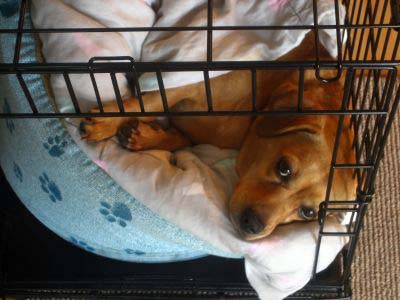Crate training a puppy
how to crate train a puppy
 When your puppy first comes home, he will probably cry in the crate for the first few days. This is normal and should not be taken as a sign that your puppy hates the crate. The puppy probably has not been away from his mom or littermates before coming to your home. You also have to take care of it by learning how to raise a puppy. Back at the litter, if separated from mom and siblings, the puppy’s instinct is to emit a high-pitched distress cry. Usually this behavior brings mom over to reunite wayward puppy with his litter. At eight weeks of age the puppy is old enough to start life as an independent dog, where crate training a puppy is recommended. The puppy may just take some time for your new puppy to learn this.
When your puppy first comes home, he will probably cry in the crate for the first few days. This is normal and should not be taken as a sign that your puppy hates the crate. The puppy probably has not been away from his mom or littermates before coming to your home. You also have to take care of it by learning how to raise a puppy. Back at the litter, if separated from mom and siblings, the puppy’s instinct is to emit a high-pitched distress cry. Usually this behavior brings mom over to reunite wayward puppy with his litter. At eight weeks of age the puppy is old enough to start life as an independent dog, where crate training a puppy is recommended. The puppy may just take some time for your new puppy to learn this.
crate training your puppy
– choose the right crate at the right size. The crate should be big enough for your puppy to stand up, turn around, and lie down comfortably, but no bigger. You can find some large dog crates. Think about a newborn human in swaddling. They feel good being wrapped up close. Same goes for your puppy, they like small spaces, so a small dog crate would be perfect. Many dog owners prefer wire crates that come with dividers so their puppy can “grow into” the full-size crate. The clear advantage to these crates is: you only have to buy one crate. Personally, I prefer plastic “airline” style crates. They are more comforting to the dog, being closed on three sides, the dog feels more protected by a plastic crate. They also provide greater protection to your floors if your puppy has an accident (which is bound to happen at least a few times) and in these instances, I find them easier to clean. I almost forgot to say that when we are talking about crate training a puppy we should choose the perfect crate. They also don’t make noise like the metal crates do which seems agreeable to both puppy and owner. The only disadvantage is that you have to buy several portable dog crates as your puppy grows, but I find the advantages to outweigh the disadvantages. This choice is a personal decision.
 – expect the puppy to cry in the crate the first couple of days. To make this more tolerable you can try these crate training puppy tips:
– expect the puppy to cry in the crate the first couple of days. To make this more tolerable you can try these crate training puppy tips:
* provide a blanket, towel, stuffed animal or some other cuddly for your puppy to sleep with for the first few days. You may need to remove this bedding later to concentrate on house breaking, but one step at a time. The first few days are just to get the pup used to the crate.
* cover the crate with a blanket. This may be especially useful if you’ve chosen a wire crate which is perfect when talking about crate training a puppy. The dark cavern feel of the blanket is just more comforting.
crate training puppies
* put the crate in a low traffic area of the house so the puppy does not become overstimulated and can settle down and rest.
* feed the puppy in the crate. Helps make the crate a comfy happy place.
* if possible, bring the puppy home on a Friday or a holiday so you have all weekend to get him used to the crate. This is especially good if you live in an apartment. Your neighbors will thank you that you did an excellent job and know how to crate training a puppy.
* also make sure the puppy is not too hot or too cold that he doesn’t have to pee or poop and that he’s not overly hungry or thirsty. If he still cries, then batten down the hatches and just wait it out. This will test your nerves, but keep reminding yourself that you have to get over this or you will regret it.
* if done properly, crying in the crate should be extinguished in about three to four days. If you mess up and reward the dog’s behavior, it will last a whole lot longer.


